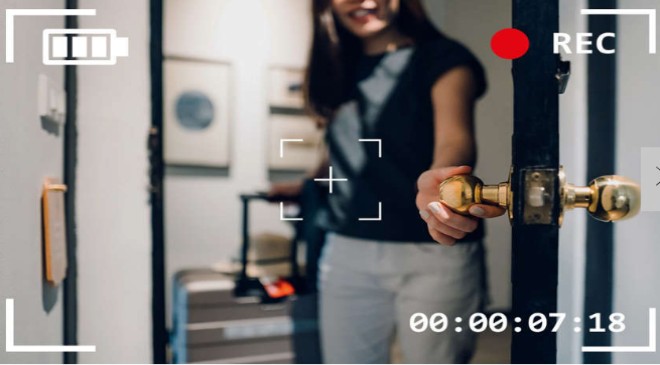Protect your privacy while traveling
When you’re traveling, the last thing you want to think about is someone spying on you. But in a 2019 survey by real estate company IPX1031, 11 percent of respondents reported finding a hidden camera in their Airbnb.
“One of the reasons this is happening is because of the ready availability of low-cost camera technology,” says Jack Plaxe, security consultant at Guidepost Solutions. Cameras with pinhole lenses that can be easily concealed are available through Amazon and other shopping sites for less than $100.
And today’s spy cameras are so small that if they’re properly concealed, there is no telltale sign, says Mike O’Rourke, CEO of Advanced Operational Concepts. Many come already installed in clock radios, smoke detectors, lamps, and other portable devices.
While the untrained eye might not be familiar with how to find hidden cameras, there are some things you can do to reduce your risk. And before your next mini family vacation, you should also learn the signs you’re about to fall for a bad Airbnb listing, the things you won’t see in hotels anymore, and the products FBI agents use to protect their homes.

How can you detect hidden cameras?
First, try to spot hidden cameras by scanning the room. Look for pieces of furniture or appliances that are in unusual places, like a lamp that appears to be specifically angled toward the bed. Keep an eye out for small holes where a hidden camera could be placed, too. To make hidden cameras easier to spot, turn off the lights and shine a flashlight around the room, looking for the glint of a camera lens.
You can also locate hidden cameras using tools like phones or scanning devices, says Paul Koblitz, managing director of technical services at TrustedSec. He recommends packing an anti-spy bug detector—which alerts you if it detects signals from hidden cameras, body wires, and even GPS—with your other travel essentials on your next vacation.

Where to look for hidden cameras
When searching for hidden cameras, some everyday objects are more likely to be culprits than others. “Cameras need three things to be effective: line of sight, reliable power, and either a network connection or internal device storage,” Koblitz says. “Because of that, cameras are usually hidden in places that can conceal the device as well as any necessary wiring.”
Typical spots to hide cameras include lamps, power adapters, outlet or light switch covers, smoke detectors, thermostats, vents, telephones, alarm clocks, TVs, TV-related items like DVD or video game consoles, and other stationary furniture like desks, mirrors, and picture frames, according to Koblitz.
If there is a bedside clock, O’Rourke unplugs it and places it in a drawer. When it’s anchored in place, he covers it with a towel. You can also sweep suspicious objects with an infrared light detector to find cameras that use night vision. Check these surprising places for hidden cameras, too.

How to find hidden cameras using mobile phones
Luckily, your smartphone can detect cameras that your eyes can’t see. There are two ways to find hidden cameras using your mobile phone, Koblitz says. The first uses your smartphone’s camera to spot infrared light coming from a camera that is recording in the dark.
- Open your smartphone’s camera, and flip the lens to selfie mode.
- Make the room as dark as possible by turning off the lights and closing the curtains.
- Scan the room slowly with your phone’s camera lens, looking for any glowing lights that are purple or white.
You can also install a network scanner app like Fing, which lists devices that are connected to the Wi-Fi network and their IP addresses.
- Connect your phone to the Wi-Fi network and open Fing.
- Android users: Tap Refresh to start scanning. iPhone users: The app will automatically begin scanning.
- Once the app finishes scanning, search the list for devices with camera manufacturers like Nest, Arlo, or Wyze, or IP addresses listed as “IP Camera.”
Not spotting any hidden cameras? You should still watch out for these red flags you’re staying in a bad hotel.

How to protect your privacy while traveling abroad
Hidden cameras are not as much of a problem in U.S. hotels, according to Plaxe and O’Rourke. “Overall in America, there is little worry in the larger and more prominent chains,” says O’Rourke. “Concern increases the further off-brand and lower budget one goes. Internationally, the opposite is true, especially in countries known to target business travelers.”
He advises taking additional precautions if you’re traveling in countries where trade secrets are targeted, such as China or Russia. “Cameras may be pointed at desks to capture computer passwords and other sensitive information,” O’Rourke says. Avoid using your laptop where criminals think you will—including the hotel lobby.
Make sure to cover your door’s peephole, too. People have used peephole reversers to film inside hotel rooms, according to O’Rourke. “Sports reporter Erin Andrews was victimized in this manner a decade ago, and she won a multi-million-dollar settlement in court,” he says. Follow these other safety tips when staying in a hotel or Airbnb.

What to do if you find a hidden camera
If you find a hidden camera or see something suspicious, Koblitz recommends immediately leaving the place you are staying and reporting what you found to the hotel, booking agency, or Airbnb customer service. You should also consider contacting local law enforcement if you feel unsafe, but don’t touch or move the device, he says. FYI, these household items could be spying on you once you get home, too.











































